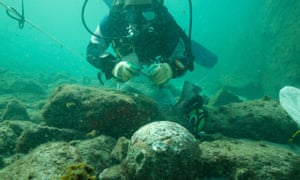
A British-led archaeological expedition has uncovered the 500-year-old wreck site of what it claims is the earliest ship ever found from Europe’s “Age of Discovery”, a Portuguese vessel that was captained by an uncle of the legendary explorer Vasco da Gama.
The Esmeralda was one of two ships that sank in a storm off the coast of Oman in 1503, only five years after Da Gama discovered the first sea route from Europe to India.
After three years of excavation and historical and scientific research – the findings of which are reported on nationalgeographic.com – the archaeologists, which included teams from Bournemouth University and Oman’s ministry of culture, announced that they had found the site of the wreck, and with it a collection of artefacts including one of the rarest coins in the world and what may be part of a previously unknown maritime astrolabe.
David Mearns, director of West Sussex-based Blue Water Recoveries which led the expedition, told the Guardian the major significance of the find was the date of its sinking, very early in the period when a handful of European maritime powers were racing to discover and exploit new routes to the east.
“This is the earliest ship [from the period of European maritime exploration of Asia] that has been found by a long stretch,” he said. “If you consider that that pre-colonial period started on a major basis with Columbus, in 1492, this is just a decade after that.”
The ship sank in a storm off the coast of what is now the small Omani island of Al-Hallaniyah in 1503, with the loss of all crew and of its captain Vicente Sodre, a maternal uncle of da Gama.
Because it broke up in shallow waters, very little of the ship itself has survived, but thousands of artefacts were uncovered from the sand in the shallow bay. Among them was an incredibly rare silver coin called an indio, of which only one other is known to exist. The coins were forged in 1499 after da Gama’s first voyage to India, which helps date the wreckage, Mearns said. Stone cannonballs appearing to bear Sodre’s initials were also discovered.
No comments:
Post a Comment